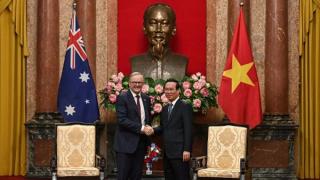On 3-4 June, Australian Prime Minister Anthony Albanese made his first official visit to Vietnam, where he met with Prime Minister Phạm Minh Chính during the 50th anniversary of diplomatic relations between the two countries. USSC Foreign Policy and Defence Research Associate Sophie Mayo evaluates the outcomes of the bilateral leaders meeting and its broader implications for US-Australia engagement in the region.
What major themes and announcements emerged from the bilateral meeting?
The bilateral meeting was preceded by a visit to Hanoi just two weeks prior from Australia’s Special Envoy for Southeast Asia, Nicholas Moore, which gave some indication of what the focus of the leaders meeting would be. During his visit, the special envoy emphasised Australia’s economic diversification imperative and intention to “build strong, long-term, two-way investment relationships, for our shared interests and economic security.”
The official readout from the leaders meeting contained major announcements on trade and investment, clean energy, education, cultural and tourism ties. Several agreements were signed, including: $105 million in foreign aid for clean energy cooperation; the establishment of regular trade minister meetings; intelligence sharing on money laundering and terrorism financing; a $250m expansion of RMIT’s Ho Chi Minh City campus; 60 new scholarships at Western Sydney University; and two new air routes.
The trip was framed as a major step in Vietnam–Australia relations and can be placed in the broader context of the Albanese government’s efforts to rebuild Australia’s relations with Southeast Asia (more below). To that end, the partners announced their intention to elevate the relationship to a Comprehensive Strategic Partnership at pace.
In your view, what is the most interesting announcement and why?
For me, the most interesting announcement is the expansion of bilateral cooperation on climate, energy, and the environment. The headline here was $105m of Australian overseas development assistance to support Vietnam’s energy transformation through sustainable infrastructure planning, stimulating private investment in clean energy infrastructure and delivering technical assistance to develop Vietnam’s critical minerals sector. Given Prime Minister Albanese’s personal interest in climate change and decarbonisation, it came as little surprise that this was highlighted as a first order issue in the post-meeting media release. In my view, announcements on climate and clean energy are significant both for the value they bring to the Vietnamese and Australian economies, and the extent to which they may help to ease the ever-present tension of non-alignment in the context of US–China competition. This is achieved by thickening the relationship outside of the points at which it directly intersects with the United States and China.
Looking forward, I hope the energy transformation announcements that came out of this bilateral add momentum to the newly announced Australia–US Climate, Critical Minerals and Clean Energy Transformation Compact. There is a clear opportunity for Vietnam to play a significant role in the downstream processing – or refinement – of Australian critical minerals, a market currently largely dominated by China. These are essential not only as inputs to the development and production of clean energy technologies, but also to defence-related technologies.
What does this meeting and adjacent diplomatic activity signify about the state of Australia and US engagement in the region?
The bilateral meeting occurs within the context of a flurry of Australian diplomatic activity in Southeast Asia, and is further evidence of the Albanese government’s priority of strengthening key relationships with ASEAN nations. The meeting’s primary focus on expanding trade and investment opportunities is indicative of the Australian Government’s emphasis on economic diversification and intention to bolster Australia’s economic relevance to Vietnam and our Southeast Asian neighbours more broadly. This is especially important ahead of the release of the Australian Government’s 2040 Southeast Asia Economic Strategy.
The Australian Prime Minister’s visit to Hanoi followed a keynote speech at the Shangri-La Dialogue. In his remarks at Shangri-La, the prime minister noted that trade, dialogue, rules and people-to-people connections between Australia and Southeast Asian nations are directly linked to the preservation of peace and security. He also emphasised Southeast Asia’s primary role in driving both global economic growth and the energy transition, stating that Australia will continue to build on our contribution to the region.
For the United States’ part, Secretary of Defense Lloyd Austin also travelled to Singapore to attend the Shangri-La Dialogue and additionally met with Japanese Minister for Defense, Hamada Yasukazu, in Tokyo to discuss security cooperation, followed by a trip to India to mark the conclusion of a new roadmap for US–India Defence Industrial Cooperation. Collectively, these engagements are a positive indication of both Australia and the United States’ continued focus on the region.






